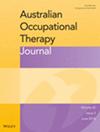Efficacy of a prewriting intervention: A pilot randomised control trial
Abstract
Introduction
Successful handwriting is dependent on accurate and efficient letter formation, which is dependent on drawing sub-strokes of letters and prewriting patterns. Currently, there is no prewriting intervention programmes with established efficacy, and little is known about children's perceptions of engaging in these programmes. This study aimed to determine the efficacy and feasibility of a prewriting intervention.
Methods
A pilot randomised control trial was conducted with embedded aspects of fidelity and acceptability. Participants included 18 typically developing 4- to 5-year-old children, attending a Western Australian kindergarten (year before first formal schooling year), randomly allocated to an intervention or waitlist control group. Baseline and post intervention data were collected using the Developmental Test of Visual Perception (Third Edition) and the Prewriting Assessment (PWA). Participants received six Peggy Lego intervention sessions, and a fidelity checklist was completed following each session. Immediately following completion of the intervention, participants provided acceptability feedback using a modified Likert scale.
Consumer and Community Involvement
Teachers and occupational therapists working with 4- to 5-year-old children provided feedback on the intervention.
Results
There was a statistically significant main effect of time on the PWA score (p = 0.003); however, the main effect of group and the interaction of group and time were non-significant (p = 0.070 and p = 0.46). The intervention was implemented with high levels of fidelity with 19 sessions (n = 34) achieving 100% fidelity. Eligibility was deemed feasible with 60% of those enrolled for the study meeting eligibility criteria. Most participants (n = 17) completed six intervention sessions. Most participants found the intervention acceptable (n = 13).
Conclusions
Exploratory analysis showed all children significantly improved their prewriting ability; however, it is likely that this effect is not attributed to intervention alone. This pilot randomised control trial is deemed feasible in terms of recruitment, retention of participants, and data collection. Further research on the efficacy of this intervention is justified.
PLAIN LANGUAGE SUMMARY
For writing to be easy to read, students need to form letters the right way and with good control. Before they can do this, they need to learn basic pencil strokes used to make letters. Handwriting programmes are used in schools and with children who find writing hard. We know some of these programmes help, but we do not know which prewriting programmes work best. We wanted to find out if a programme called Peggy Lego helps and if it is easy to use. We did six Peggy Lego sessions with 18 kindergarten children in Western Australia. All of the children got better at their prewriting skills, but we could not tell if Peggy Lego helped more than routine teaching, or if the children improved over time. We asked the students how they felt about the programme. Most said they liked it and thought their drawing got better, even though it was a bit hard. Future research could look at whether feeling more confident helps children when they start learning to write letters.


 求助内容:
求助内容: 应助结果提醒方式:
应助结果提醒方式:


